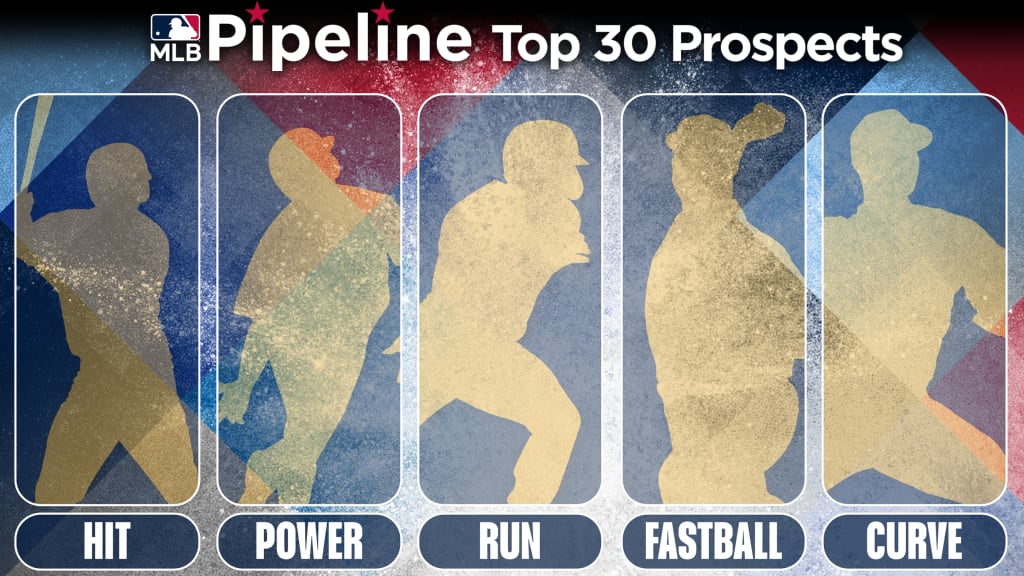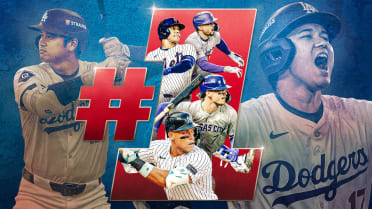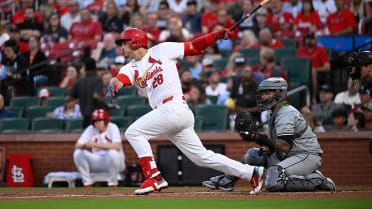Breaking down the Top 30 Prospects lists

All of MLB Pipeline’s 2020 Top 30 Prospects lists have been published. Overall, 4,159 grades for tools and pitchers were assigned to the 900 players we ranked across all 30 teams’ Top 30 lists.
The grades -- from the average overall grade of each player on a team’s Top 30 down to the individual tools of those players -- give an indication of which farm systems are thriving. How those grades sync up with MLB Pipeline’s 2020 farm system rankings list is very informative.
It should come as no surprise that eight of the Top 10 teams in our farm system rankings also appear on the list of the 10 teams whose Top 30 prospects have the highest average overall grades:
Overall (Top 30 ranking in parenthesis)
- Dodgers, 48.5 (3)
- Rays, 47.9 (1)
- Tigers, 47.33 (5)
- Padres, 47.03 (2)
- D-backs, 47.0 (6)
- Rangers, 46.83 (21)
- Marlins, 46.67 (4)
- Mariners, 46.5 (9)
- Yankees, 46.41 (22)
- Twins, 46.33 (7)
The Braves (No. 8) and Giants (No. 10) are the only Top 10-ranked systems not on the above list, though both just missed the cut at 46.17, good for a share of the No. 11 spot on the list along with the Royals. The Rangers have the highest average overall grades among non-Top 10 systems -- their 46.83-point average beats out five of the Top 10 farms -- while the Yankees aren’t far behind. The two organizations’ systems are ranked Nos. 21 and 22, respectively, among all 30 teams.
Top teams, bottom farms
Sustained success at the Major League level often comes at the cost of having a weaker farm system, as teams with an open competitive window are more likely to trade from their prospect contingent or sacrifice future Draft picks to sign top free agents.
- Cubs, 45.5
- Cardinals, 45.17
- Red Sox, 45.0
- Nationals, 44.67
- Brewers, 44.35
- Astros, 44.17
Therefore, it should not come as much of a surprise that the above list features the four most recent World Series champions as well as a pair of perennial playoff contenders in the Cardinals and Brewers. The notable exception to the rule is the Dodgers, owners of the highest average overall grades and MLB Pipeline’s No. 3 system. In recent years, they have managed to strike a consistent balance between fielding a competitive Major League roster while also maintaining a top-ranked farm.
Top 5 hitting and pitching prospects
Speaking of the Dodgers, they rank in the top three among each team’s Top 30 prospects’ overall grades by hitters and pitchers.
Average overall hitter grades
- Dodgers, 49.67
- Mariners, 48.75
- Rays, 48.67
- Mets, 47.92
- D-backs, 47.81
Average overall pitching grades
- Padres, 47.92
- Tigers, 47.67
- Dodgers, 47.33
- Blue Jays, 47.31
- Rays, 47.19
That the Rays and Dodgers are in the top five of both lists comes with the territory of having one of baseball’s better farm systems. Tampa Bay’s spot on the hitters list makes plenty of sense considering the Rays house MLB Pipeline No. 1 overall prospect Wander Franco, and the same can be said about the Dodgers and No. 2 prospect Gavin Lux. Of course, both organizations have a deeper crop of young hitters extending well beyond their respective top prospects.
The Mariners, Mets and D-backs’ systems all feature a collection of highly touted young hitters, many of whom already rank among MLB Pipeline’s Top 100 prospects. The Astros (44.17), Angels (44.24) and Brewers (44.35) have the lowest average overall hitting grades among all 30 teams.
The Rays and Dodgers both trail San Diego on the pitching list. The presence of MacKenzie Gore, MLB Pipeline’s top-ranked pitching prospect (No. 5 overall), in the Padres’ system certainly contributes to the team’s placement atop the list for a second straight year. The Tigers rank second in pitching, with hurlers comprising half of its Top 30 list, including nine of the top 16 spots. Toronto has only 13 pitchers in its Top 30 but still claimed a spot in the top five.
Individual tool grades
Breaking down our team Top 30 lists even further, we come to individual grades. This includes the position players’ five tools, as well as four pitch grades plus control for the arms. Our top 10 organizations appear a total of 21 times. The Yankees and Rangers lead the way with five appearances on the tools lists, followed by Tampa Bay, Oakland and the Dodgers with four apiece.
Hit
T1) D-backs, 51.6
T1) Cubs, 51.6
T1) Indians, 51.6
4) Dodgers, 51.3
5) Rangers, 51.1
Hit (individual)
- Wander Franco, Rays, 80
- Nick Madrigal, White Sox, 70
- 23 tied at 60
Power
T1) Mets, 50.4
T1) Cardinals, 50.4
3) Giants, 50.3
4) Dodgers, 50.0
5) Padres, 49.5
Power (individual)
T1) Luis Robert, White Sox, 65
T1) Jo Adell, Angels, 65
3) 36 tied at 60
Run
- Royals, 55.7
- Rays, 55.0
- Angels, 54.3
- A’s, 54.2
T5) Orioles, 53.8
T5) Mariners, 53.8
Run (individual)
T1) CJ Abrams, Padres, 80
T1) Jordyn Adams, Angels, 80
T1) James Beard, White Sox, 80
T1) Dasan Brown, Blue Jays, 80
T1) Trent Deveaux, Angels, 80
T1) Jorge Mateo, A's, 80
Arm
- Marlins, 57.9
- Braves, 57.5
- Rays, 56.7
T4) Rangers, 56.3
T4) Yankees, 56.3
T4) Mets, 56.3
Arm (individual)
T1) 17 tied at 70
Field
- Royals, 55.4
- A’s, 55.0
- Orioles, 55.0
- Mariners, 54.6
- Yankees, 54.1
Field (individual)
T1) Cristian Pache, Braves, 70
T1) Evan White, Mariners, 70
T3) Nine tied at 65
Fastball
- Indians, 62.9
- Dodgers, 61.3
- Yankees, 61.1
T4) D-backs, 60.7
T4) Cubs, 60.7
Fastball (individual)
T1) Nine tied at 80
Curveball
- Rockies, 58.3
- Yankees, 57.2
- Rangers, 56.4
- Nationals, 55.5
T5) D-backs, 55.0
T5) Cubs, 55.0
T5) Blue Jays, 55.0
Curveball (individual)
- Bryan Abreu, Astros, 70
T2) Six tied at 65
Slider
- Rays, 56.3
- Rangers, 55.7
- Red Sox, 55.6
- Astros, 54.7
- Tigers, 54.5
Slider (individual)
T1) Seven tied at 65
Changeup
- Padres, 53.3
- Marlins, 53.1
- Phillies, 53.0
- Yankees, 52.5
- A’s, 52.3
Changeup (individual)
- Jackson Kowar, Royals, 70
- Jesus Luzardo, A's, 65
T3) 23 tied at 60
Control
- Rays, 53.1
- Brewers, 50.9
T3) A’s, 50.8
T3) Marlins, 50.8
T3) Mariners, 50.8
T3) White Sox, 50.8
T3) Blue Jays, 50.8
Who’s ready to help?
Having a lot of talent that’s ready to contribute soon is something every organization hopes for. Teams that are rebuilding, in particular, can look at who is expected to make it up in the next two seasons and hope the turnaround can happen quicker than expected. The Braves have already capitalized on their rebuilding effort, and it might not be long until the White Sox, Padres and Royals do too. Here's a look at which teams have the most Top 30 prospects with big league ETAs of 2020 or '21:
- White Sox, 22
- Padres, 22
- A’s, 22
T4) Braves, 21
T4) Royals, 21
T4) Twins, 21
Youth movements
The average age of the players on each team's Top 30 list could be an indicator of which farm systems will be next to ascend into the Top 10. Here's a list of the teams with the youngest average age on their Top 30 lists, which suggests that both New York teams, as well as the Padres, could have very good systems for a very long time, the Pirates, Rangers and Indians could rise to the top of the Top 10 list and that we should all keep an eye on the Red Sox and Blue Jays.
- Angels, 6/15/1999
- Yankees, 12/29/1998
- Rangers, 12/23/1998
- Mets, 10/24/1998
- Pirates, 8/14/1998
- Padres, 8/7/1998
- Brewers, 8/7/1998
- Indians, 8/2/1998
- Red Sox, 7/25/1998
- Blue Jays, 6/23/1998
Youngest players
- Jose Corniel, Mariners (06/22/2003)
- Roberto Campos, Tigers (06/14/2003)
- Adrian Placencia, Angels (06/02/2003)
- Reginald Preciado, Padres (05/16/2003)
- Jose Salas, Marlins (04/26/2003)
- Adael Amador, Rockies (04/11/2003)
- Hedbert Perez (04/04/2003)
- Aeverson Arteaga, Giants (03/16/2003)
- Emmanuel Rodriguez, Twins (02/28/2003)
- Luis Medina, Brewers (02/24/2003)
Mike Rosenbaum is a senior prospect analyst for Prep Baseball Report. Follow him on Twitter at @GoldenSombrero.




